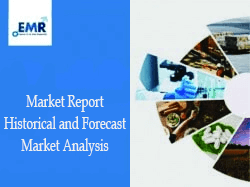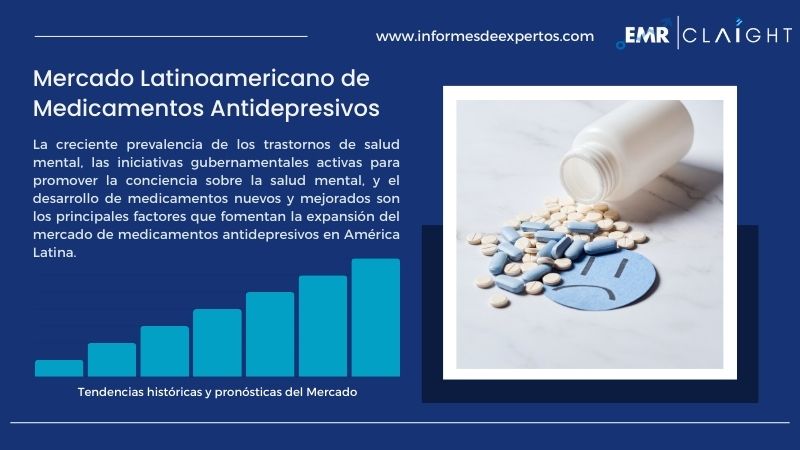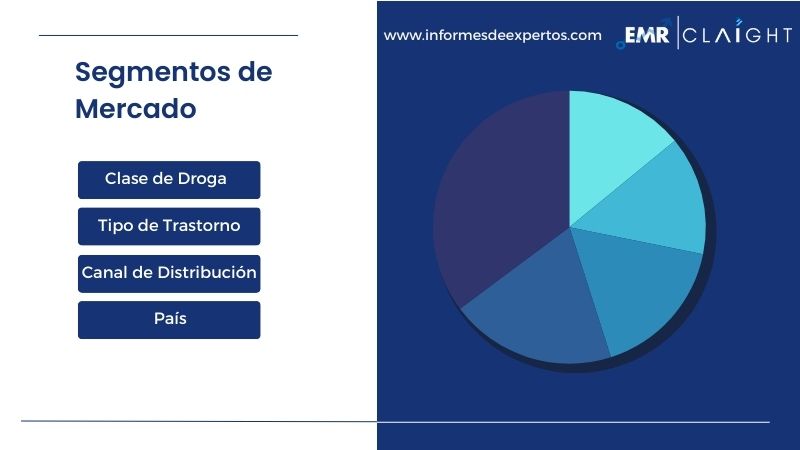Informes

Mercado Latinoamericano de Medicamentos Antidepresivos – Por Clase de Droga (Antipsicóticos Atípicos, Inhibidores de la Recaptación de Serotonina y Norepinefrina (IRSN), Otros); Por Tipo de Trastorno (Trastorno Depresivo Mayor, Desorden Obsesivo Compulsivo, Otros); Por Canal de Distribución (Farmacias Hospitalarias, Farmacias Minoristas, Farmacias en Línea, Otros); Por País (Brasil, México, Argentina, Chile, Otros); Dinámica del Mercado y Panorama Competitivo
Perspectiva del Mercado Latinoamericano de Medicamentos Antidepresivos
El mercado latinoamericano de medicamentos antidepresivos alcanzó un valor de USD 1,36 mil millones en el año 2024. Se estima que el mercado crecerá a una tasa de crecimiento anual compuesta del 6,5% entre 2025 y 2034, para alcanzar un valor de 2,40 mil millones de USD en 2034.

Informe de muestra gratuito con índice: Obtenga un informe de muestra gratuito con tabla de contenido
La depresión es un trastorno mental que generalmente se caracteriza por un estado de ánimo bajo constante, ausencia de emociones positivas y diversos síntomas cognitivos, físicos, conductuales y emocionales. Los medicamentos antidepresivos se utilizan para el tratamiento de los trastornos depresivos, que corrigen el desequilibrio químico, como la falta de serotonina en el cerebro, y controlan el estado de ánimo y las emociones del paciente. Estos medicamentos ayudan a aliviar los signos de ansiedad, el trastorno afectivo estacional y la distimia.
El mercado latinoamericano de medicamentos antidepresivos está impulsado por la alta prevalencia de la depresión debido a los factores como el aislamiento social y el ambiente laboral estresante que aumentan el número de personas víctimas de la depresión y trastornos relacionados. Además, los hábitos alimentarios inadecuados, la incapacidad para adaptarse a los rápidos cambios en el estilo de vida, el aumento de la población geriátrica y la creciente prevalencia de los trastornos de ansiedad son otras causas principales de la depresión, todo lo cual conduce a una mayor demanda de medicamentos antidepresivos. Además, el aumento de la conciencia sobre el estado de la enfermedad y las necesidades clínicas requeridas también estimulan el crecimiento de la industria objetivo.
Aparte de esto, la pandemia de COVID-19 también aumentó el miedo, estrés y la preocupación entre la gente. Los bloqueos impuestos por los gobiernos interrumpieron la rutina diaria de mucha gente, lo que impactó negativamente a la salud mental de las personas. Esto impulsó aún más las ventas de medicamentos para la depresión. Además, se espera que la aparición de técnicas novedosas para el desarrollo de fármacos con menos efectos secundarios impulse aún más el crecimiento de la industria.

Informe de muestra gratuito con índice: Obtenga un informe de muestra gratuito con tabla de contenido
Medicamentos Antidepresivos: Segmentación del Mercado
Según la clase de droga, el mercado se segmenta en:
- Antipsicóticos Atípicos
- Inhibidores de la Recaptación de Serotonina y Norepinefrina (IRSN)
- Inhibidores Selectivos de la Recaptación de Serotonina (ISRS)
- Estimulantes del Sistema Nervioso Central (SNC)
- Antidepresivos Tricíclicos
- Inhibidores de la Monoaminooxidasa
- Otros
Por el tipo de trastorno, la industria se divide en:
- Trastorno Depresivo Mayor
- Desorden Obsesivo Compulsivo
- Trastorno de Ansiedad Generalizada
- Trastorno de Pánico
- Otros
Sobre la base del canal de distribución, el mercado se ha segmentado en:
- Farmacias Hospitalarias
- Farmacias Minoristas
- Farmacias en Línea
- Otros
Además, el estudio ha examinado a fondo el mercado en Brasil, México, Argentina, Chile, y en otros países de la América Latina.
Rising Cases of Depression and Other Related Disorders to Fuel the Latin America Antidepressant Drugs Market
The most prominent factor driving the growth of the antidepressant drugs market in Latin America is the rising prevalence of mental diseases such as social anxiety, stress, and depression. Thus, the escalating number of people falling prey to depression accelerates the demand for antidepressants drugs in the market. Moreover, the COVID-19 pandemic also represents one of the key factors propelling the depression drugs market growth, as lockdown and other measures issued by the governments severely impacted the mental health of individuals, resulting in stress and depression among people. Over the forecast period, the development of antidepressants with minimal side effects and long-term results are anticipated to fuel the industry's growth. However, poor efficacy and safety profiles of the drug and the availability for non-pharmacological therapies obstruct the market growth.

Informe de muestra gratuito con índice: Obtenga un informe de muestra gratuito con tabla de contenido
Actores Claves de la Industria de Latinoamericano de Medicamentos Antidepresivos
Algunos de los principales actores mundiales son Pfizer, Eli Lilly and Company, AstraZeneca, Otsuka Pharmaceutical, Novartis, Allergan, Johnson & Johnson, Zhejiang NHU Company Ltd, Sebela Pharmaceuticals, entre otros.
Las bases de datos incluidas en el informe sobre el mercado latinoamericano de medicamentos antidepresivos proporcionan importantes impactos en el desarrollo presentadas por las principales empresas, teniendo en cuenta sus ingresos. Este informe consta de los valores del período histórico (2018-2024) y del período de pronóstico (2025-2034) con patrones de evaluación ampliados que se llevan a cabo mediante el análisis IDE basado en clase de droga, tipo de trastorno, canal de distribución y país del mercado para determinar el movimiento del estudio.
Además, el proyecto estudiado y analizado se basa en información detallada sobre el modelo de las cinco fuerzas de Porter, las estrategias de los principales actores existentes y sus carteras con diferenciación beneficiosa en innovación de productos en la industria. Por lo tanto, se concluye que el análisis del poder de negociación de los compradores, el poder adquisitivo de los consumidores, la amenaza de los sustitutos y la nueva entrada con el efecto de la reactivación económica y el desarrollo se evalúa para subrayar el poderoso impacto en el mercado.
Preguntas Clave Respondidas en Este Informe:
- ¿Cuál es el rendimiento actual y la trayectoria proyectada del mercado latinoamericano de medicamentos antidepresivos?
- ¿Cuáles son los principales impulsores, oportunidades y retos para el mercado latinoamericano de medicamentos antidepresivos?
- ¿Cómo afecta cada impulsor, restricción y oportunidad al mercado latinoamericano de medicamentos antidepresivos?
- ¿Cuáles son los principales mercados regionales estudiados en el informe?
- ¿Cuál es la región líder en el mercado latinoamericano de medicamentos antidepresivos?
- ¿Qué factores contribuyen al dominio de esta región en el mercado latinoamericano de medicamentos antidepresivos?
- ¿Cuál es la tasa de crecimiento histórica del mercado latinoamericano de medicamentos antidepresivos en los últimos años?
- ¿Cuáles son sus respectivas fortalezas y enfoques de mercado?
- ¿Cómo contribuyen estas empresas a la dinámica general del mercado latinoamericano de medicamentos antidepresivos?
- ¿Cuál es la estructura competitiva del mercado?
- ¿Quiénes son los principales actores del mercado latinoamericano de medicamentos antidepresivos?
Beneficios Clave para las Partes Interesadas:
- El informe de la industria de IDE ofrece un análisis cuantitativo exhaustivo de varios segmentos del mercado, las tendencias históricas y actuales del mercado, las previsiones del mercado y la dinámica del mercado latinoamericano de medicamentos antidepresivos de 2018 a 2034.
- El informe ofrece los datos más recientes sobre los impulsores, retos y oportunidades del mercado. El informe traza los principales mercados regionales, así como los que registran la tasa de crecimiento más rápida. Además, permite a las partes interesadas identificar los principales mercados nacionales de cada región.
- El análisis de las cinco fuerzas de Porter ayuda a las partes interesadas a evaluar el impacto de los nuevos operadores, la rivalidad competitiva, el poder del proveedor, el poder del comprador y la amenaza de sustitución. Ayuda a las partes interesadas a analizar el nivel de competencia en la industria de latinoamericano de medicamentos antidepresivos y su atractivo.
- El panorama competitivo permite a las partes interesadas comprender su entorno competitivo y ofrece una visión de las posiciones actuales de los principales actores del mercado.
Alcance del Mercado:
|
Características del Informe |
Detalles |
|
Año Base de la Estimación: |
2024 |
|
Datos Históricos: |
2018-2024 |
|
Datos de Pronóstico: |
2025-2034 |
|
Alcance del Informe: |
Tendencias Históricas y Previsiones del Mercado, Impulsores y Limitantes de
|
|
Desglose por |
|
|
Desglose por |
|
|
Desglose por |
|
|
Desglose por País: |
|
|
Dinámica del Mercado: |
|
|
Análisis de Precios: |
|
|
Panorama Competitivo: |
|
|
Empresas Cubrietas: |
|
*En Informes de Expertos siempre nos esforzamos por brindarle la información más reciente. Los números de artículo son solo indicativos y pueden diferir del informe real.
Language of the Report – English
Sin embargo, el informe puede estar disponible en español por un costo adicional.
1 Preface
2 Report Coverage – Key Segmentation and Scope
3 Report Description
3.1 Market Definition and Outlook
3.2 Properties and Applications
3.3 Market Analysis
3.4 Key Market Players
4 Key Assumptions
5 Executive Summary
5.1 Overview
5.2 Key Drivers
5.3 Key Developments
5.4 Competitive Structure
5.5 Key Industrial Trends
6 Snapshot
6.1 Latin America
6.2 By Region
7 Industry Opportunities and Challenges
8 Latin America Antidepressant Drugs Market Analysis
8.1 Key Industry Highlights
8.2 Latin America Antidepressant Drugs Historical Market (2018-2024)
8.3 Latin America Antidepressant Drugs Market Forecast (2025-2034)
8.4 Latin America Antidepressant Drugs Market by Drug Class
8.4.1 Atypical Antipsychotics
8.4.1.1 Market Share
8.4.1.2 Historical Trend (2018-2024)
8.4.1.3 Forecast Trend (2025-2034)
8.4.2 Serotonin-Norepinephrine Reuptake Inhibitors (SNRIs)
8.4.2.1 Market Share
8.4.2.2 Historical Trend (2018-2024)
8.4.2.3 Forecast Trend (2025-2034)
8.4.3 Selective Serotonin Reuptake Inhibitors (SSRIs)
8.4.3.1 Market Share
8.4.3.2 Historical Trend (2018-2024)
8.4.3.3 Forecast Trend (2025-2034)
8.4.4 Central Nervous System (CNS) Stimulants
8.4.4.1 Market Share
8.4.4.2 Historical Trend (2018-2024)
8.4.4.3 Forecast Trend (2025-2034)
8.4.5 Tricyclic Antidepressants
8.4.5.1 Market Share
8.4.5.2 Historical Trend (2018-2024)
8.4.5.3 Forecast Trend (2025-2034)
8.4.6 Monoamine Oxidase Inhibitors
8.4.6.1 Market Share
8.4.6.2 Historical Trend (2018-2024)
8.4.6.3 Forecast Trend (2025-2034)
8.4.7 Others
8.5 Latin America Antidepressant Drugs Market by Disorder Type
8.5.1 Major Depressive Disorder
8.5.1.1 Market Share
8.5.1.2 Historical Trend (2018-2024)
8.5.1.3 Forecast Trend (2025-2034)
8.5.2 Obsessive-Compulsive Disorder
8.5.2.1 Market Share
8.5.2.2 Historical Trend (2018-2024)
8.5.2.3 Forecast Trend (2025-2034)
8.5.3 Generalized Anxiety Disorder
8.5.3.1 Market Share
8.5.3.2 Historical Trend (2018-2024)
8.5.3.3 Forecast Trend (2025-2034)
8.5.4 Panic Disorder
8.5.4.1 Market Share
8.5.4.2 Historical Trend (2018-2024)
8.5.4.3 Forecast Trend (2025-2034)
8.5.5 Others
8.6 Latin America Antidepressant Drugs Market by Distribution Channel
8.6.1 Hospital Pharmacies
8.6.1.1 Market Share
8.6.1.2 Historical Trend (2018-2024)
8.6.1.3 Forecast Trend (2025-2034)
8.6.2 Retail Pharmacies
8.6.2.1 Market Share
8.6.2.2 Historical Trend (2018-2024)
8.6.2.3 Forecast Trend (2025-2034)
8.6.3 Online
8.6.3.1 Market Share
8.6.3.2 Historical Trend (2018-2024)
8.6.3.3 Forecast Trend (2025-2034)
8.6.4 Others
8.7 Latin America Antidepressant Drugs Market by Country
8.7.1 Market Share
8.7.1.1 Brazil
8.7.1.2 Argentina
8.7.1.3 Mexico
8.7.1.4 Chile
8.7.1.5 Others
9 Regional Analysis
9.1 Brazil
9.1.1 Historical Trend (2018-2024)
9.1.2 Forecast Trend (2025-2034)
9.2 Argentina
9.2.1 Historical Trend (2018-2024)
9.2.2 Forecast Trend (2025-2034)
9.3 Mexico
9.3.1 Historical Trend (2018-2024)
9.3.2 Forecast Trend (2025-2034)
9.4 Chile
9.4.1 Historical Trend (2018-2024)
9.4.2 Forecast Trend (2025-2034)
10 Market Dynamics
10.1 SWOT Analysis
10.1.1 Strengths
10.1.2 Weaknesses
10.1.3 Opportunities
10.1.4 Threats
10.2 Porter’s Five Forces Analysis
10.2.1 Supplier’s Power
10.2.2 Buyers Powers
10.2.3 Threat of New Entrants
10.2.4 Degree of Rivalry
10.2.5 Threat of Substitutes
10.3 EMR’s Key Indicators for Demand
10.4 EMR’s Key Indicators for Price
11 Value Chain Analysis
12 Price Analysis
13 Competitive Landscape
13.1 Market Structure
13.2 Key Company Profiles
13.2.1 Company Overview
13.2.2 Product Portfolio
13.2.3 Demographic Reach and Achievements
13.2.4 Certifications
14 Industry Events and Developments
*The list of players in the competitive landscape section can be customised or made more exhaustive based on your specific requirements.*
En 2024, el mercado alcanzó un valor de USD 1,36 mil millones.
Se prevé que el mercado de medicamentos antidepresivos en América Latina crezca a una CAGR del 6,5% entre 2025 y 2034.
Se estima que el mercado objetivo experimentará un crecimiento saludable en el período de previsión de 2025-2034 para alcanzar los USD 2,40 mil millones en 2034.
La creciente prevalencia de los trastornos de salud mental, las iniciativas gubernamentales activas para promover la conciencia sobre la salud mental, y el desarrollo de medicamentos nuevos y mejorados son los principales factores que fomentan la expansión del mercado de medicamentos antidepresivos en América Latina.
La creciente demanda de medicina personalizada y un creciente enfoque en las medidas preventivas son las tendencias predominantes en el mercado.
Las principales regiones consideradas en el informe son Brasil, México, Argentina, Chile y otros países de la América Latina.
Según la clase de drogas, el mercado se segrega en antipsicóticos atípicos, inhibidores de la recaptación de serotonina y norepinefrina (IRSN), inhibidores selectivos de la recaptación de serotonina (ISRS), estimulantes del sistema nervioso central (SNC), antidepresivos tricíclicos, e inhibidores de la monoamino oxidasa, entre otros.
Los diferentes canales de distribución seguidos en el estudio de mercado son farmacias hospitalarias, farmacias minoristas, y farmacias en línea, entre otros.
Las empresas clave en el mercado de medicamentos antidepresivos de América Latina son Pfizer, Eli Lilly and Company, AstraZeneca, Otsuka Pharmaceutical, Novartis, Allergan, Johnson & Johnson, Zhejiang NHU Company Ltd, Sebela Pharmaceuticals y otras.
Excel Data Set
USD1799
-
Datos completos en formato Excel para un usuario
-
Impresión no permitida
-
Entrega por Email
-
Personalización limitada gratuita (pre-venta)Soporte de analista post ventaDescuento del 50% en la Próxima ActualizaciónUsuario Único
USD3199
USD2999-
Restringido a un usuario
-
Solo una impresión
-
Disponible en PDF
-
Personalización limitada gratuita (pre-venta)Soporte de analista post ventaDescuento del 50% en la Próxima ActualizaciónCinco Usuarios
USD4199
USD3999-
Restringido a cinco usuarios
-
Una impresión por usuario
-
Disponible en PDF
-
Personalización limitada gratuita (pre-venta)
-
Soporte de analista post venta
-
Descuento del 50% en la Próxima Actualización
Multiusuario
USD5199
USD4999-
Usuarios ilimitados dentro de la organización
-
Impresiones ilimitadas
-
Disponible en PDF
-
Personalización limitada gratuita (pre-venta)
-
Soporte de analista post venta
-
Descuento del 50% en la Próxima Actualización
Póngase en Contacto¿Cualquier Pregunta? Hable con un Analista
Solicitar una MuestraVer una Muestra
Solicitar PersonalizaciónSe le olvidó algo? Pregunte Ahora
¿Por qué Informes de Expertos?La Gente Adecuada
Somos técnicamente excelentes, estratégicos, prácticos, experimentados y eficientes; nuestros analistas son cuidadosamente seleccionados en función de tener los atributos correctos para trabajar con éxito y ejecutar proyectos basados en sus expectativas.
Metodología Correcta
Aprovechamos nuestra tecnología de vanguardia, nuestro acceso a bases de datos confiables y nuestro conocimiento de los modelos actuales utilizados en el mercado para ofrecerle soluciones de investigación que se adapten a sus necesidades y lo pongan a la vanguardia.
Precio Justo
Realizamos una investigación exhaustiva y de calidad superior a precios razonables, inigualables y que demuestran nuestra comprensión de su estructura de recursos. Además, ofrecemos descuentos atractivos en nuestros próximos informes.
Apoyo Adecuado
Nuestro equipo de analistas expertos está a su disposición entera para ofrecerle resultados óptimos personalizados para satisfacer sus necesidades precisas dentro del plazo especificado y ayudarlo a comprender mejor la industria.
Informes SimilaresLas tendencias más destacadas del mercado son el creciente uso del cannabidiol en productos para el cuidado de la piel y la introducción de productos con CBD.
El mercado de cannabidiol está experimentando un enorme crecimiento debido a la creciente concienciación sobre los beneficios del cannabidiol entre la gente, la creciente legalización de los produc...
El aumento del uso de tratamientos de quimioterapia, la creciente demanda de fármacos de terapia dirigida y los avances en las tecnologías de administración de fármacos son los factores destacados...
El desarrollo del mercado de la reparación del cartílago de rodilla puede atribuirse al creciente número de casos de daño del cartílago de rodilla debido al aumento de las actividades deportivas ...
El mercado de jarabe para la tos muestra un gráfico ascendente debido a la prevalencia de resfriados y tos entre la población, que crea un efecto de bloqueo en el buen funcionamiento del cuerpo huma...
Newsletter





